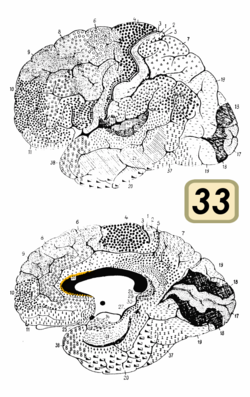Brodmann area 33
Appearance
| Brodmann area 33 | |
|---|---|
 Brodmann area 33 (shown in orange) | |
 Medial surface of the brain with Brodmann's areas numbered. | |
| Details | |
| Identifiers | |
| Latin | Area praegenualis |
| NeuroLex ID | birnlex_1766 |
| FMA | 68630 |
| Anatomical terms of neuroanatomy | |
Brodmann area 33, also known as pregenual area 33, is a subdivision of the cytoarchitecturally defined cingulate region of cerebral cortex. It is a narrow band located in the anterior cingulate gyrus adjacent to the supracallosal gyrus in the depth of the callosal sulcus, near the genu of the corpus callosum.[1] Cytoarchitecturally it is bounded by the ventral anterior cingulate area 24 and the supracallosal gyrus (Brodmann-1909). The pregenual area 33 is heavily involved in emotions, especially happy emotions.[2][3]
Image
-
Animation.
-
Medial view.
See also
Wikimedia Commons has media related to Brodmann area 33.
References
- ^ L., Nicolae; G., Lacob; O., Popescu B. (2010-11-25). "Gelastic Seizures in a Patient with Right Gyrus Cinguli Astrocytoma". Journal of Medicine and Life. 3 (4): 433–436. ISSN 433-436. PMC 3019062. PMID 21254744.
{{cite journal}}: Check|issn=value (help) - ^ Vogt, Brent A. (2005). "Pain and emotion interactions in subregions of the cingulate gyrus". Nature Reviews Neuroscience. 6 (7): 533–544. doi:10.1038/nrn1704. PMC 2659949. PMID 15995724.
- ^ Gasquoine, Philip Gerard (2013-01-03). "Localization of function in anterior cingulate cortex: from psychosurgery to functional neuroimaging". Neuroscience and Biobehavioral Reviews. 37 (3): 340–348. doi:10.1016/j.neubiorev.2013.01.002. ISSN 1873-7528. PMID 23313645. S2CID 19692387. Archived from the original on 2022-08-21. Retrieved 2022-08-21 – via National Library of Medicine.


